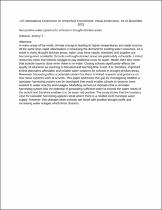JavaScript is disabled for your browser. Some features of this site may not work without it.
- ResearchSpace
- →
- Research Publications/Outputs
- →
- Books
- →
- View Item
| dc.contributor.author |
Gibberd, Jeremy T

|
|
| dc.date.accessioned | 2022-10-03T07:14:43Z | |
| dc.date.available | 2022-10-03T07:14:43Z | |
| dc.date.issued | 2021-12 | |
| dc.identifier.citation | Gibberd, J.T. 2021. Net-positive water systems for schools in drought-stricken areas. http://hdl.handle.net/10204/12500 . | en_ZA |
| dc.identifier.uri | http://hdl.handle.net/10204/12500 | |
| dc.description.abstract | In many areas of the world, climate change is leading to higher temperatures and water scarcity. At the same time, rapid urbanisation is increasing the demand for existing water resources. As a result in many drought-stricken areas, water costs have rapidly increased and supplies are becoming more unreliable. Schools in drought-stricken areas are particularly vulnerable. Limited resources mean that schools struggle to pay additional costs for water. Health risks also mean that schools have to close when there is no water. Closing schools significantly affects the quality of education as teaching is disrupted and learning time is lost. It is, therefore, important to find alternative affordable and reliable water solutions for schools in drought-stricken areas. Rainwater harvesting offers a potential solution but there is limited research and guidance on how these systems work at schools. This paper addresses this gap by investigating whether a rainwater harvesting system can be developed that would enable schools to become more resilient to water scarcity and outages. Modelling carried out indicates that a rainwater harvesting system has the potential of generating sufficient water to exceed the water needs of the school and therefore enables it to be water net-positive. The study shows that the business case for rainwater harvesting appears weak where there is a reliable local municipalwater supply. However, this changes when schools are faced with punitive drought tariffs and increasing water outages which force closures. | en_US |
| dc.format | Abstract | en_US |
| dc.language.iso | en | en_US |
| dc.relation.uri | https://cibworld.org/cib-international-conference-on-smart-built-environment-14-15-december-2021-proceedings-now-published/ | en_US |
| dc.source | CIB International Conference on Smart Built Environment, Virtual Conference, 14-15 December 2021 | en_US |
| dc.subject | Climate change | en_US |
| dc.subject | Drought-stricken areas | en_US |
| dc.subject | Net-positive water systems | en_US |
| dc.subject | Rainwater harvesting | en_US |
| dc.title | Net-positive water systems for schools in drought-stricken areas | en_US |
| dc.type | Conference Presentation | en_US |
| dc.description.pages | 32-42 | en_US |
| dc.description.note | Due to copyright restrictions, the attached PDF file contains the abstract of the published item. For access to the published version, please consult the publisher's website: https://cibworld.org/cib-international-conference-on-smart-built-environment-14-15-december-2021-proceedings-now-published/ | en_US |
| dc.description.cluster | Smart Places | en_US |
| dc.description.impactarea | Infrastructure Innovation | en_US |
| dc.identifier.apacitation | Gibberd, J. T. (2021). Net-positive water systems for schools in drought-stricken areas. http://hdl.handle.net/10204/12500 | en_ZA |
| dc.identifier.chicagocitation | Gibberd, Jeremy T. "Net-positive water systems for schools in drought-stricken areas." <i>CIB International Conference on Smart Built Environment, Virtual Conference, 14-15 December 2021</i> (2021): http://hdl.handle.net/10204/12500 | en_ZA |
| dc.identifier.vancouvercitation | Gibberd JT, Net-positive water systems for schools in drought-stricken areas; 2021. http://hdl.handle.net/10204/12500 . | en_ZA |
| dc.identifier.ris | TY - Conference Presentation AU - Gibberd, Jeremy T AB - In many areas of the world, climate change is leading to higher temperatures and water scarcity. At the same time, rapid urbanisation is increasing the demand for existing water resources. As a result in many drought-stricken areas, water costs have rapidly increased and supplies are becoming more unreliable. Schools in drought-stricken areas are particularly vulnerable. Limited resources mean that schools struggle to pay additional costs for water. Health risks also mean that schools have to close when there is no water. Closing schools significantly affects the quality of education as teaching is disrupted and learning time is lost. It is, therefore, important to find alternative affordable and reliable water solutions for schools in drought-stricken areas. Rainwater harvesting offers a potential solution but there is limited research and guidance on how these systems work at schools. This paper addresses this gap by investigating whether a rainwater harvesting system can be developed that would enable schools to become more resilient to water scarcity and outages. Modelling carried out indicates that a rainwater harvesting system has the potential of generating sufficient water to exceed the water needs of the school and therefore enables it to be water net-positive. The study shows that the business case for rainwater harvesting appears weak where there is a reliable local municipalwater supply. However, this changes when schools are faced with punitive drought tariffs and increasing water outages which force closures. DA - 2021-12 DB - ResearchSpace DP - CSIR J1 - CIB International Conference on Smart Built Environment, Virtual Conference, 14-15 December 2021 KW - Climate change KW - Drought-stricken areas KW - Net-positive water systems KW - Rainwater harvesting LK - https://researchspace.csir.co.za PY - 2021 T1 - Net-positive water systems for schools in drought-stricken areas TI - Net-positive water systems for schools in drought-stricken areas UR - http://hdl.handle.net/10204/12500 ER - | en_ZA |
| dc.identifier.worklist | 25229 | en_US |






